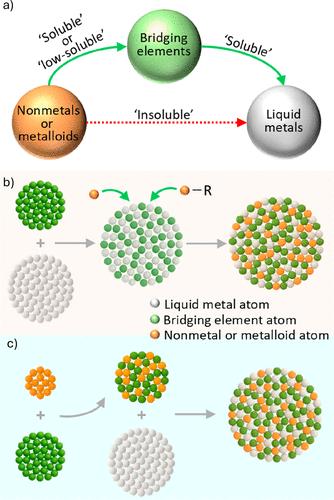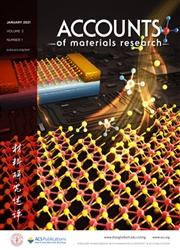Bridge Doping Unlocks Hidden Pathways in Liquid Metal Chemistry
IF 14.7
Q1 CHEMISTRY, MULTIDISCIPLINARY
引用次数: 0
Abstract
Figure 1. (a) ‘Bridge doping’ mechanism for dissolution of insoluble nonmetals and metalloids in liquid metals using secondary elements with cross solubility. Illustrations of (b) ‘top-to-bottom’ and (c) ‘bottom-to-top’ strategies for the ‘bridge doping’ concept (gray: liquid metal, orange: nonmetals or metalloids insoluble in liquid metals, green: secondary element with solubility in both liquid metal and nonmetal/metalloid). The surface of liquid metal might naturally deviate from the core in following the classical phase diagrams. Spatiotemporal clustering and localized enrichment may occur in liquid metals, leading to surface differs incredibly from the core. The potential supercooling after alloying might affect the atomically dispersed state of dopants in liquid metals. Liquid metals stay dynamically layered near the surface, which further complicates dopant incorporation. Figure 2. Role of different secondary elements in the bridge solubility of C, F, S, P, B, and Si elements in liquid metals. Green and red arrows show solubility and insolubility, respectively, while the blue arrow indicates the bridge solubility between secondary elements and liquid metals. Dr. Mohammad Bagher Ghasemian received his PhD in Materials Science and Engineering from UNSW Sydney in 2018. He is currently a Senior Research Fellow in the School of Chemical and Biomolecular Engineering at the University of Sydney and a Visiting Research Fellow in the School of Chemical Engineering at UNSW Sydney. Previously, he worked as a researcher at the Centre for Smart Supramolecules at Pohang University of Science & Technology (POSTECH), South Korea, and as a Postdoctoral Fellow at the Centre for Advanced Solid and Liquid Based Electronics and Optics at UNSW Sydney. His research focuses on liquid metals for the preparation and fabrication of functional materials, including nanostructures and 2D materials, with potential applications in photocatalysis, sensing, flexible devices, optics, and electronics. Dr. Francois-Marie Allioux is a Research Fellow in the School of Chemical and Biomolecular Engineering at the University of Sydney. He was previously a Postdoctoral Fellow in the School of Chemical Engineering at UNSW Sydney. He received his PhD in Materials Science in 2017 from the Institute for Frontier Materials, Deakin University (Geelong, Australia), and a Master’s degree in Chemical Engineering from Université Paul Sabatier (Toulouse, France). His research centres on low-melting-point and liquid-metal systems for environmental processes and technologies. Kourosh Kalantar-Zadeh is a Professor at the School of Chemical and Biomolecular Engineering at the University of Sydney. He is also one of the Australian Research Council Laureate Fellows of 2018. Professor Kalantar-Zadeh was a professor of Chemical Engineering at UNSW, and prior to that a Professor of Electronic Engineering at RMIT, Australia. Professor Kalantar-Zadeh is involved in research in the fields of analytical chemistry, materials sciences, gastroenterology, electronics and sensors, and has coauthored of >500 highly cited scientific papers. He is a member of the editorial boards of journals including ACS Applied Nano Materials (associate editor), ACS Sensors, Advanced Materials Technologies, Nanoscale, Applied Surface Science and ACS Nano. Professor Kalantar-Zadeh is best known for his works on ingestible sensors, liquid metals and two-dimensional semiconductors. He led his group to the invention of an ingestible chemical sensor: human gas sensing capsule, one of the breakthroughs in the field of medical devices. Professor Kalantar-Zadeh has received several international awards for his scientific contributions including the 2017 IEEE Sensor Council Achievement, 2018 American Chemical Society Advances in Measurement Science Lectureship awards and 2020 Robert Boyle Prize of Royal Society of Chemistry. The authors would like to acknowledge the Australian Research Council (ARC) Discovery Project Grant DP230102813 and Discovery Project Grant DP240101086. This article references 27 other publications. This document has been updated Click for further information. This article has not yet been cited by other publications.

桥式掺杂解开液态金属化学中隐藏的途径
图1所示。(a)利用具有交叉溶解度的次级元素在液态金属中溶解不溶性非金属和类金属的“桥式掺杂”机制。(b)“从上到下”和(c)“从下到上”的“桥式掺杂”概念策略示意图(灰色:液态金属,橙色:非金属或不溶于液态金属的类金属,绿色:在液态金属和非金属/类金属中都具有溶解性的次级元素)。遵循经典相图,液态金属表面可能会自然地偏离核心。液态金属可能发生时空聚集和局部富集,导致表面与核心的差异很大。合金化后潜在的过冷会影响掺杂剂在液态金属中的原子分散状态。液态金属在表面附近保持动态分层,这进一步使掺杂剂的掺入复杂化。图2。不同次生元素对液态金属中C、F、S、P、B、Si等元素桥溶解度的影响绿色和红色箭头分别表示溶解度和不溶解度,蓝色箭头表示次生元素与液态金属之间的桥溶解度。Mohammad Bagher Ghasemian博士于2018年在悉尼新南威尔士大学获得材料科学与工程博士学位。他目前是悉尼大学化学与生物分子工程学院的高级研究员,悉尼新南威尔士大学化学工程学院的访问研究员。此前,他曾在韩国浦项科技大学(POSTECH)智能超分子中心担任研究员,并在悉尼新南威尔士大学高级固体和液体电子与光学中心担任博士后研究员。他的研究重点是用于制备和制造功能材料的液态金属,包括纳米结构和二维材料,在光催化、传感、柔性器件、光学和电子学方面具有潜在的应用。Francois-Marie Allioux博士是悉尼大学化学与生物分子工程学院的研究员。他曾在悉尼新南威尔士大学化学工程学院担任博士后研究员。他于2017年获得迪肯大学(澳大利亚吉朗)前沿材料研究所材料科学博士学位,并于法国图卢兹保罗萨巴蒂尔大学(universit Paul Sabatier)化学工程硕士学位。他的研究集中在低熔点和液态金属系统的环境过程和技术。Kourosh Kalantar-Zadeh是悉尼大学化学与生物分子工程学院的教授。他也是2018年澳大利亚研究委员会获奖者之一。Kalantar-Zadeh教授是新南威尔士大学化学工程教授,在此之前是澳大利亚皇家墨尔本理工学院电子工程教授。Kalantar-Zadeh教授从事分析化学、材料科学、胃肠病学、电子学和传感器等领域的研究,并与人合著了500篇高引用率的科学论文。他是《ACS应用纳米材料》、《ACS传感器》、《先进材料技术》、《纳米尺度》、《应用表面科学》和《ACS纳米》等期刊的编辑委员会成员。Kalantar-Zadeh教授最著名的研究领域是可摄取传感器、液态金属和二维半导体。他带领他的团队发明了一种可摄取的化学传感器:人体气体传感胶囊,这是医疗器械领域的突破之一。Kalantar-Zadeh教授因其科学贡献获得了多项国际奖项,包括2017年IEEE传感器委员会成就奖,2018年美国化学学会测量科学进步讲座奖和2020年皇家化学学会罗伯特博伊尔奖。作者感谢澳大利亚研究委员会(ARC)发现项目资助DP230102813和发现项目资助DP240101086。本文引用了其他27篇出版物。本文档已更新,点击查看更多信息。这篇文章尚未被其他出版物引用。
本文章由计算机程序翻译,如有差异,请以英文原文为准。
求助全文
约1分钟内获得全文
求助全文

 求助内容:
求助内容: 应助结果提醒方式:
应助结果提醒方式:


